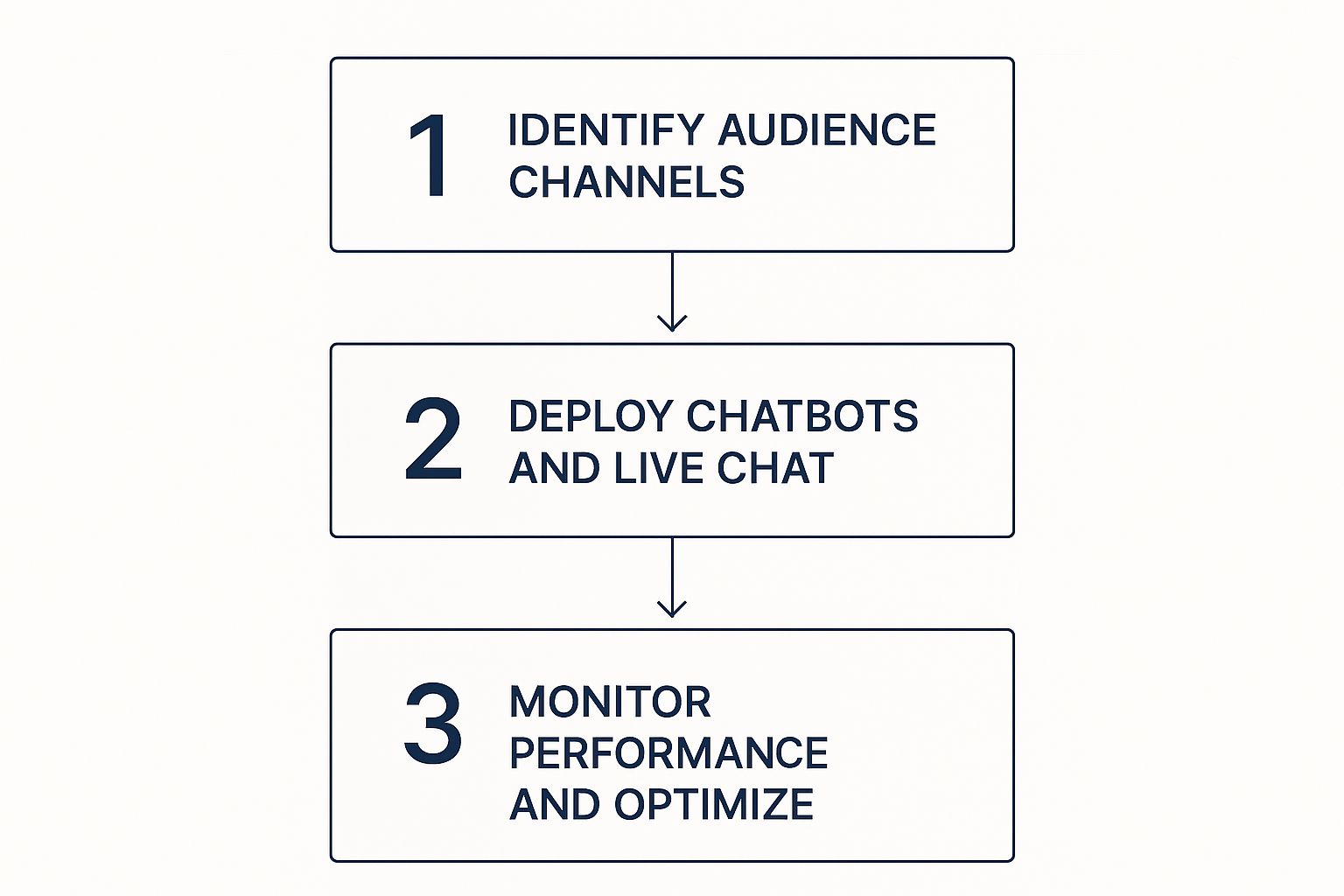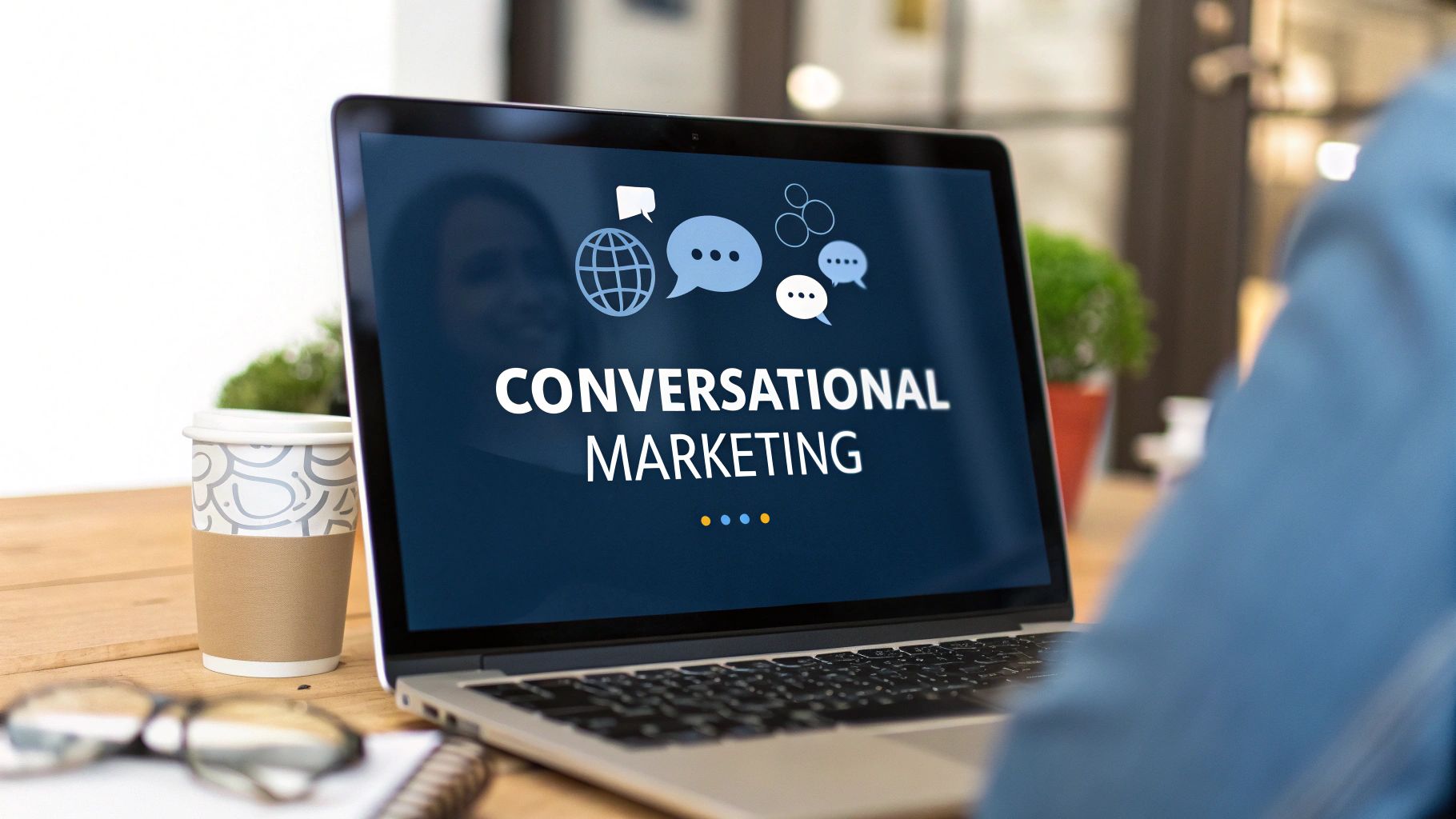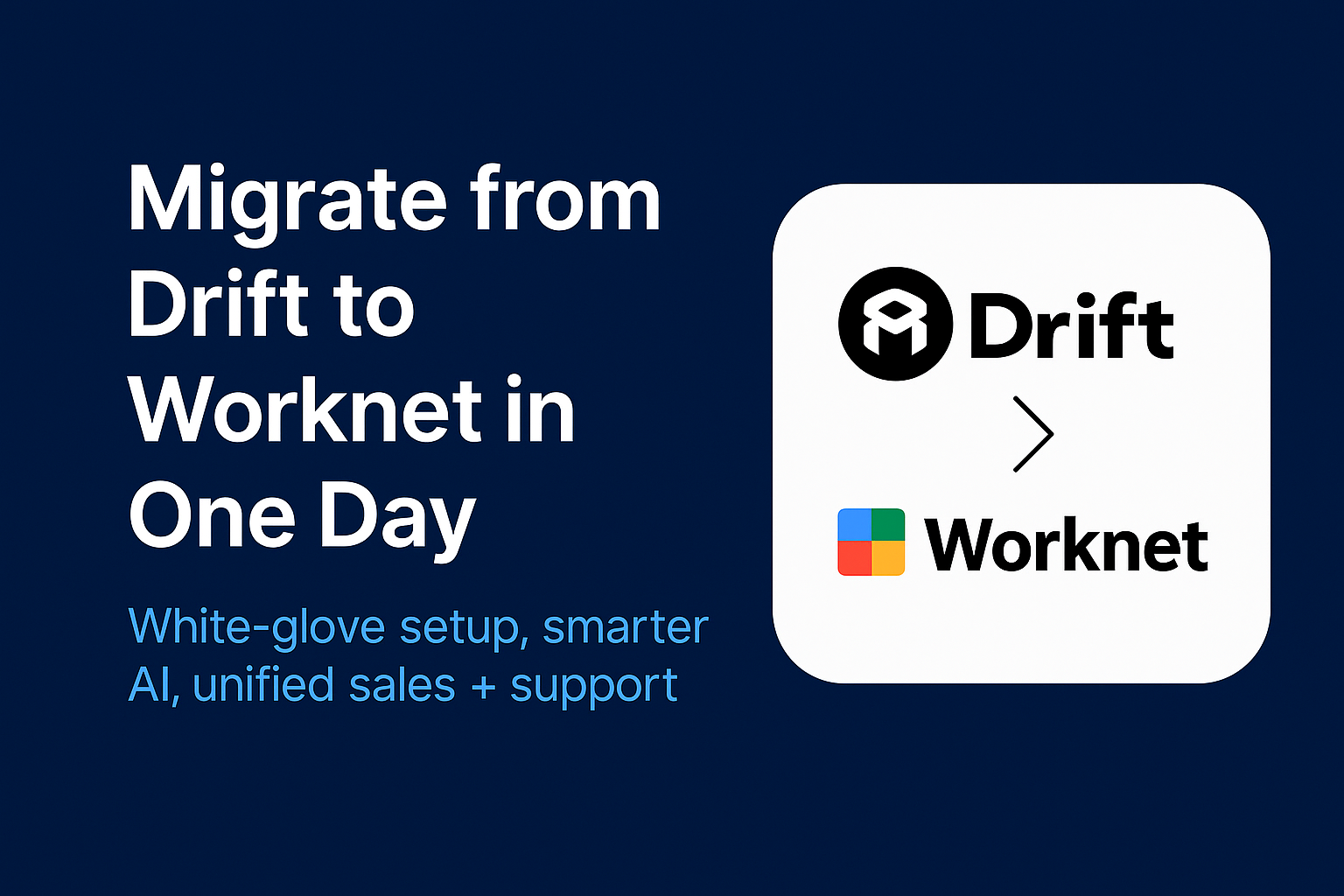What Is Conversational Marketing? A Complete Guide
Picture this: you walk into a store, and instead of wandering around aimlessly, a friendly expert immediately asks what you’re looking for and points you in the right direction. That’s the essence of what conversational marketing is in a nutshell. It’s about turning your website from a static, one-way brochure into a dynamic, two-way conversation that helps customers in real time.
What Is Conversational Marketing, Really?
At its core, conversational marketing is a customer-centric strategy that uses real-time, one-on-one conversations to engage website visitors the second they land on your site. This is a huge departure from traditional marketing, which often feels like a monologue where brands just talk at their audience. Conversational marketing flips the script, creating a dialogue where brands talk with their customers.
It's like having your best salesperson available 24/7, right on your website.
This approach leans heavily on tools like smart AI chatbots and live chat to kickstart these conversations. The goal is to understand what a visitor needs and deliver value on the spot. Instead of making people fill out a form and then wait for an email, you open a direct line of communication to answer questions and start building a real connection right away.
The whole idea is to grease the wheels of the sales process. By engaging people when their interest is highest, you eliminate friction and create a far more personal and efficient path to becoming a customer.
To see just how different these two approaches are, let's break them down side-by-side.
Traditional Marketing vs Conversational Marketing
This table really highlights the fundamental shift: from a passive, "wait-and-see" approach to an active, "let's-talk-now" model that meets modern customer expectations head-on.
The Shift to Real-Time Engagement
Today's customers have come to expect instant answers and interactions that feel like they were made just for them. The data paints a clear picture of this move toward automated, on-demand support. For instance, some forecasts show that by 2025, a staggering 85% of customer interactions will be managed without a human agent, all thanks to AI and automation.
This trend isn't some far-off future concept; it's happening right now. A huge chunk of these chatbot conversations already takes place on mobile phones, underscoring just how important it is to meet customers on the devices they use every day. If you're curious about the numbers driving this change, you can dig into these conversational marketing trends.
Ultimately, this move toward instant, AI-powered dialogue is what makes the whole strategy tick. To get a deeper look at how this technology is changing the game, check out this complete guide to conversational AI for customer service.
The real magic happens when you find the perfect balance between automated efficiency and the irreplaceable value of human expertise. We actually cover how to strike that balance in our guide on conversational AI for customer service.
The Building Blocks of Your Conversational Strategy

A great conversational marketing strategy isn't just about plugging in a single tool and calling it a day. It’s about creating a connected ecosystem where technology and your team work together, creating a smooth experience for every visitor. Think of it like a highly-trained pit crew—each member has a specific role, but they all operate in sync to win the race.
To build this system, you really only need three core components. While each one has its own job to do, their real power comes from how they work together as a single unit. Let's break down these essential building blocks.
AI Chatbots for 24/7 Availability
First up, you have AI-powered chatbots. These are your tireless, front-line responders, always ready to engage. Their biggest advantage is being on the clock 24/7, offering instant answers and guidance long after your human team has logged off. This constant availability is a game-changer for grabbing the attention of visitors, no matter their time zone.
A well-built chatbot is brilliant at handling routine, high-volume tasks. This includes things like:
- Answering frequently asked questions: Instantly providing info on pricing, features, or company policies.
- Qualifying new leads: Asking a few smart questions to gauge a visitor's needs and see if they're a good fit.
- Booking meetings: Popping demos or consultations right onto your sales team’s calendars without any back-and-forth.
By automating these first-touch interactions, chatbots free up your human agents to jump into more complex, valuable conversations. It means no potential customer ever gets left hanging.
Live Chat for Human Connection
While chatbots are fantastic for speed and efficiency, some questions just need a human touch. That's where live chat shines. It gives customers a direct line to a real person who can handle nuanced support issues, dive deep into product details, or talk through a unique problem that automation can't solve.
The goal isn't to replace humans but to empower them. A great conversational strategy uses automation to handle the simple tasks, allowing human agents to step in when their expertise will make the biggest impact.
This human connection is absolutely essential for building trust and sorting out complex problems. For instance, if a prospect is weighing your SaaS against a competitor, a live agent can offer a personalized walkthrough, understand their specific pain points, and build a rapport that a bot just can't replicate.
Messaging Apps for Meeting Customers Where They Are
Finally, a truly complete strategy has to reach beyond your website. You need to meet people on the platforms they already use every day, like WhatsApp, Facebook Messenger, or even SMS. Weaving these messaging apps into your marketing allows you to keep the conversation going in a space that feels natural and convenient for the customer.
This approach is perfect for sending things like order updates, sharing exclusive offers, or gently re-engaging leads who browsed your site but didn't convert. It turns a one-off website chat into an ongoing relationship, which helps build loyalty and keeps your brand top of mind.
Why Conversational Marketing Is a Game-Changer

It’s one thing to know what conversational marketing is, but it’s another to see what it can actually do for a business. This isn't just about adding a chatbot to your site; it’s about transforming a slow, one-way street into a dynamic, two-way conversation that drives real growth.
The biggest win? Speed.
Think about the old way: a prospect fills out a form and then... waits. Their interest cools with every hour that ticks by. Conversational marketing flips that script by engaging people instantly, right when their curiosity is highest. If you want to see just how much speed matters, it’s worth learning how to master inbound lead response time — the data is eye-opening.
This immediacy is what makes the whole approach so powerful. You're not just responding faster; you're connecting with people at the exact moment they’re ready to talk.
Supercharge Your Sales Cycle
Conversational tools do more than just chat—they qualify leads for you, 24/7. An AI-powered bot can ask the right questions about a visitor's needs, their budget, and when they're looking to buy, all in a natural, back-and-forth conversation.
Imagine your sales team starting their day with a list of pre-qualified, high-intent leads who are already warmed up and ready for a serious discussion. No more cold calls or dead-end discovery meetings. They can jump right into what they do best: closing deals.
The result is a much shorter sales cycle because all that initial legwork—the tedious qualification and scheduling—is handled automatically.
By eliminating the "waiting game" and automating initial qualification, conversational marketing hands your sales team warmer, more informed leads, directly accelerating your revenue pipeline.
This proactive approach can deliver some seriously impressive outcomes. By reading behavioral signals and engaging at the right time, companies see tangible results. One business, for example, generated over 50 new opportunities, added roughly $1 million in closed revenue, and boosted its website conversions by 33% after putting a conversational strategy in place.
Build Lasting Customer Loyalty
The conversation doesn’t stop after the sale. This strategy is also a powerhouse for keeping customers happy and loyal for the long haul.
By offering instant, 24/7 support through chatbots, you give customers answers the second they need them, without forcing them to wait for business hours. This kind of always-on assistance creates a fantastic customer experience and shows you respect their time.
And when a problem gets too tricky for a bot? The conversation can be smoothly handed off to a human agent, blending the efficiency of automation with a necessary personal touch. This hybrid support model is a key part of modern customer care, a topic we cover in our guide to the AI copilot for customer service.
How to Build Your First Conversational Workflow
Jumping into conversational marketing doesn’t mean you have to tear down your entire strategy and start from scratch. You can get started by building out one simple, effective workflow. The best way to think about it is through a three-step framework: Engage, Understand, and Recommend.
This is really just the digital version of a great retail experience. Think about it: a helpful store clerk greets you (Engage), asks a few questions to figure out what you're looking for (Understand), and then points you toward the perfect product (Recommend). It's a simple, human-centric approach that turns a passive visit into a guided, valuable interaction.
Step 1: Engage Proactively
The first move is on you. Don't just sit back and wait for a visitor to dig around for a "Contact Us" page. You need to be the one to start the conversation with a helpful, proactive greeting. This isn't about being pushy; it’s about making it clear you're there to help.
A well-timed chat prompt can make all the difference. For instance, a SaaS company could have a message pop up on its pricing page saying something like, "Trying to decide between our plans? I can help you find the right fit in about 30 seconds." It’s a low-pressure way to open a dialogue right when someone is making a critical decision.
Step 2: Understand Visitor Needs
Once someone responds, your goal is to quickly figure out why they're here. This is where your chatbot acts like a friendly guide, asking a few questions to uncover what the person is trying to do. The trick is to keep it short and to the point.
This is not the time for a long survey. Instead, use simple multiple-choice options or direct questions that help you qualify them. You might ask things like:
- "Are you currently using another tool for [solving X problem]?"
- "What's your main goal today? ('Get pricing,' 'Book a demo,' 'Ask a support question')"
- "How big is your team?"
These questions give you the context you need to guide them effectively without making it feel like an interrogation.
Step 3: Recommend the Best Path Forward
After you've got a handle on their needs, the final step is to give them an immediate, helpful recommendation. This is where the payoff is. You're essentially clearing a path straight to the solution they need, dramatically shortening the time it takes for them to get value.
This infographic lays out the core steps for putting your conversational strategy into play and making it better over time.

As you can see, the process of identifying your channels, engaging visitors, and monitoring performance is a continuous cycle of improvement.
For a hot lead—someone who fits your ideal customer profile and asks about sales—the bot can instantly book a meeting on a rep’s calendar. For someone with a tech question, it can send over a link to the right knowledge base article. This instant gratification is what conversational marketing is all about: no more waiting around for answers. To build out these workflows at scale, it's worth looking into business process automation tools that can help manage the moving parts.
SaaS Use Case in Action: A visitor lands on your pricing page. A chatbot pops up: "Hi! See a plan you like?" The visitor clicks, "I have a few questions." The bot asks two qualifying questions and determines they're a high-intent lead. It then responds: "It sounds like our Pro plan is a great fit. A product expert is free to chat right now. Connect now?" In moments, a passive browser becomes an active sales opportunity.
Real-World Conversational Marketing Examples

Theory is one thing, but seeing how conversational marketing plays out in the real world is where it all clicks. The truth is, many companies are already miles ahead, winning over customers by making simple, two-way conversations the heart of their strategy. These aren't just buzzwords; these are real examples with measurable results.
From big names in tech to nimble startups, businesses are using these real-time dialogues to tackle everyday challenges like generating better leads, taking the pressure off support teams, and closing deals faster. Looking at how they do it can give you a clear-cut blueprint for your own efforts.
Let’s break down a couple of common scenarios.
How Tech Brands Automate Demo Booking
For any SaaS company, the product demo is the holy grail of conversions. But the old way of doing things—filling out a form and hoping for a call back—is a leaky bucket. You lose interested, high-intent people who simply don't want to wait. This is where conversational marketing completely changes the game.
Picture this: a potential customer is on your website, digging into a complex feature page. Instead of letting them wander off confused, a smart AI chatbot pops up with a simple, helpful question: "Got any questions about how this works?"
That single prompt kicks off a powerful sequence. The bot can:
- Answer technical questions on the spot, pulling directly from your knowledge base.
- Qualify the lead in seconds by asking about their company and what they’re trying to achieve.
- Book a demo directly onto a sales rep's calendar if they're a good match.
This simple flow transforms a passive website visit into an active, productive sales conversation. The outcome? More qualified meetings booked, a much faster sales cycle, and a pipeline that’s actually moving.
E-commerce Stores That Drive Sales with Personalization
In the cutthroat world of e-commerce, making things personal is how you win. Conversational tools, especially on platforms like Facebook Messenger where customers already are, are brilliant for creating that "just for you" shopping experience.
Think of a clothing store using a Messenger bot as a personal stylist. The bot can chat with a customer about their tastes, budget, and the event they're shopping for. Using that info, it can instantly serve up tailored recommendations, complete with pictures and buy-now links.
This approach works because it’s exactly what people want. We know that 76% of people are more likely to engage with brands that send them relevant, targeted messages. This isn't just about feeling good; it translates directly to sales.
These personalized chats aren't a one-and-done deal, either. They build lasting loyalty. Sending order updates, handling support queries, and even offering style tips after the purchase—all through chat—creates a genuine relationship that keeps customers coming back. It’s a huge piece of a smart customer success automation puzzle.
Best Practices for Human-Centric Conversations
Getting started with a conversational marketing strategy is one thing, but the real test is the quality of the conversations themselves. The goal is to make every interaction feel genuinely helpful and human—not like talking to a clunky robot. Nailing a few key practices will ensure your technology builds trust instead of creating friction.
Think of it this way: every conversation, whether with a bot or a live agent, is a direct reflection of your brand. That's why it's so important to maintain a consistent brand voice and personality in every chat. If your brand is known for being playful and quirky, your chatbot’s greetings should match that vibe. If you’re a more professional service, the language needs to be polished and to the point. This consistency creates a reliable experience people can count on.
Create a Smooth Bot-to-Human Handoff
The handoff from a bot to a human is a make-or-break moment. A clumsy transition can sour the entire experience, leaving customers frustrated. The secret is making it feel completely seamless.
Your chatbot should act like a helpful assistant, gathering all the essential context—the customer's name, the problem they're trying to solve, and what they've already tried. All this information needs to be passed directly to the human agent so the customer never has to repeat themselves. When done right, it doesn’t feel like a transfer. It feels like an expert has just stepped into the room to join the conversation.
A great handoff is a sign of respect for your customer's time. It shows them your team and your tech are working together as one, totally focused on getting their problem solved.
Personalize Responsibly with Data
Using data to tailor a conversation can make a customer feel truly seen. You can reference things like past purchases or company size to offer relevant advice. It shows you’re paying attention.
But be careful—there’s a fine line between helpful personalization and being creepy. A good rule of thumb is to use data to add value, not just to prove you have it. For instance, saying, "I see you're looking at our enterprise plan, which is popular with other companies in your industry," adds helpful context. Reciting their click-by-click browsing history does not. Always ask yourself: does this piece of information help the customer achieve their goal right now?
Your Questions, Answered: FAQs About Conversational Marketing
Still have a few things you're wondering about conversational marketing? Let's clear up some of the most common questions we get.
Is Conversational Marketing Just for Big Companies?
Not at all. While large enterprises use it to manage massive volumes of inquiries, conversational marketing is a game-changer for small and medium-sized businesses, too. Modern tools have made this approach incredibly accessible. With affordable chatbots and live chat software, even a small team can offer round-the-clock support, qualify leads while they sleep, and deliver a standout customer experience. It lets you compete on service, not just size.
How Does Conversational Marketing Affect SEO?
Conversational marketing can give your SEO a nice, indirect boost. Think about it: when a visitor lands on your site and gets immediate help from a chatbot, they're more likely to stick around. This increases your site's dwell time and lowers your bounce rate. To search engines like Google, these are strong signals that your site is valuable and engaging to users, which can help improve your rankings over time.
Can I Put My Entire Sales Process on Autopilot?
While you can automate huge chunks of your sales funnel—like capturing lead info, answering basic questions, and booking demos—it’s not about total automation. The real magic happens when you blend smart automation with a human touch.
The best approach is to let chatbots handle the repetitive, top-of-funnel tasks. Once a prospect shows real interest, the system should seamlessly hand them over to a live sales rep who can build a relationship and close the deal. It’s about empowering your sales team, not replacing them.
Ready to stop watching visitors leave and start turning conversations into customers? Worknet.ai uses smart, AI-driven conversations to engage every visitor and connect them to the right expert at the perfect moment. Convert more trials, increase lifetime value, and see your growth take off.
Learn how Worknet.ai can drive your growth.
Article created using Outrank
FAQs
.png)
Lorem ipsum dolor sit amet, consectetur adipiscing elit. Suspendisse varius enim in eros elementum tristique. Duis cursus, mi quis viverra ornare, eros dolor interdum nulla, ut commodo diam libero vitae erat. Aenean faucibus nibh et justo cursus id rutrum lorem imperdiet. Nunc ut sem vitae risus tristique posuere.
Lorem ipsum dolor sit amet, consectetur adipiscing elit. Suspendisse varius enim in eros elementum tristique. Duis cursus, mi quis viverra ornare, eros dolor interdum nulla, ut commodo diam libero vitae erat. Aenean faucibus nibh et justo cursus id rutrum lorem imperdiet. Nunc ut sem vitae risus tristique posuere.
Lorem ipsum dolor sit amet, consectetur adipiscing elit. Suspendisse varius enim in eros elementum tristique. Duis cursus, mi quis viverra ornare, eros dolor interdum nulla, ut commodo diam libero vitae erat. Aenean faucibus nibh et justo cursus id rutrum lorem imperdiet. Nunc ut sem vitae risus tristique posuere.
Lorem ipsum dolor sit amet, consectetur adipiscing elit. Suspendisse varius enim in eros elementum tristique. Duis cursus, mi quis viverra ornare, eros dolor interdum nulla, ut commodo diam libero vitae erat. Aenean faucibus nibh et justo cursus id rutrum lorem imperdiet. Nunc ut sem vitae risus tristique posuere.
Lorem ipsum dolor sit amet, consectetur adipiscing elit. Suspendisse varius enim in eros elementum tristique. Duis cursus, mi quis viverra ornare, eros dolor interdum nulla, ut commodo diam libero vitae erat. Aenean faucibus nibh et justo cursus id rutrum lorem imperdiet. Nunc ut sem vitae risus tristique posuere.
Lorem ipsum dolor sit amet, consectetur adipiscing elit. Suspendisse varius enim in eros elementum tristique. Duis cursus, mi quis viverra ornare, eros dolor interdum nulla, ut commodo diam libero vitae erat. Aenean faucibus nibh et justo cursus id rutrum lorem imperdiet. Nunc ut sem vitae risus tristique posuere.
Lorem ipsum dolor sit amet, consectetur adipiscing elit. Suspendisse varius enim in eros elementum tristique. Duis cursus, mi quis viverra ornare, eros dolor interdum nulla, ut commodo diam libero vitae erat. Aenean faucibus nibh et justo cursus id rutrum lorem imperdiet. Nunc ut sem vitae risus tristique posuere.
Lorem ipsum dolor sit amet, consectetur adipiscing elit. Suspendisse varius enim in eros elementum tristique. Duis cursus, mi quis viverra ornare, eros dolor interdum nulla, ut commodo diam libero vitae erat. Aenean faucibus nibh et justo cursus id rutrum lorem imperdiet. Nunc ut sem vitae risus tristique posuere.
Lorem ipsum dolor sit amet, consectetur adipiscing elit. Suspendisse varius enim in eros elementum tristique. Duis cursus, mi quis viverra ornare, eros dolor interdum nulla, ut commodo diam libero vitae erat. Aenean faucibus nibh et justo cursus id rutrum lorem imperdiet. Nunc ut sem vitae risus tristique posuere.
Lorem ipsum dolor sit amet, consectetur adipiscing elit. Suspendisse varius enim in eros elementum tristique. Duis cursus, mi quis viverra ornare, eros dolor interdum nulla, ut commodo diam libero vitae erat. Aenean faucibus nibh et justo cursus id rutrum lorem imperdiet. Nunc ut sem vitae risus tristique posuere.

.svg)


.webp)
.webp)
.webp)





